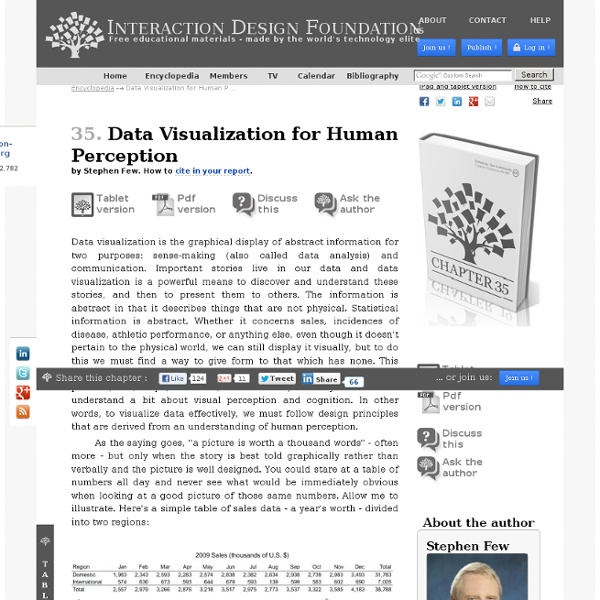



http://www.interaction-design.org/encyclopedia/data_visualization_for_human_perception.html
Gestalt principles of form perception by Mads Soegaard Gestalt psychology attempts to understand psychological phenomena by viewing them as organised and structured wholes rather than the sum of their constituent parts. Thus, Gestalt psychology dissociates itself from the more 'elementistic'/reductionistic/decompositional approaches to psychology like structuralism (with its tendency to analyse mental processes into elementary sensations) and it accentuates concepts like emergent properties, holism, and context. In the 30s and 40s Gestalt psychology was applied to visual perception, most notably by Max Wertheimer, Wolfgang Khler, and Kurt Koffka who founded the so-called gestalt approaches to form perception. Their aim was to investigate the global and holistic processes involved in perceiving structure in the environment (e.g.
Visualization Types - Introduction to Data Visualization This taxonomy is based on a data taxonomy from: Shneiderman, B. (1996). The eyes have it: A task by data type taxonomy for information visualizations. Proceedings of IEEE Symposium on Visual Languages - Boulder, CO (pp. 336-343). The taxonomy is heavily weighted toward the more abstract information visualization techniques and is less representative of scientific visualizations, which can be highly specialized by domain and are more difficult to generalize. Hull (1935) Classics in the History of Psychology An internet resource developed by Christopher D. Green York University, Toronto, Ontario
How to choose the right chart (corrected) A friend recently asked me, “how do you choose the right chart?” I thought about it, and essentially sent her a list of the sites that I have bookmarked, along with a few comments. This is by no means an exhaustive list, and it’s meant more for a layperson, but here’s the list, nonetheless. If you have more suggestions, I’d love to hear them.
Why We Buy: How to Avoid 10 Costly Cognitive Biases The psychology of money: post-purchase rationalisation, the relativity trap, rosy retrospection, the restraint bias and more… We all make mistakes with money, some more than others. And in this economy, who needs it? But many of these mistakes are avoidable if we can understand how we think about money. Here are 10 biases that psychological research has shown affect our judgement…and how to avoid them. Visual Encoding Michael Dubakov, TargetProcess Founder September, 2012 How do people perceive information? How designers can thrive on this process to help people understand data faster? Let’s try to look into this complex field and explore some basic principles. The visual encoding is the way in which data is mapped into visual structures, upon which we build the images on a screen. The goal of this article is to provide an engaging introduction to visual encoding, and to give some hands-on examples of how it helps to present data in a meaningful way.
10 Simple Postures That Boost Performance Psychological research suggests simple actions can project power, persuade others, increase empathy, boost cognitive performance and more… We tend to think of body language as something that expresses our internal states to the outside world. But it also works the other way around: the position of our body also influences our mind. As the following psychological research shows, how we move can drive both thoughts and feelings and this can boost performance.
Inside the Battle to Define Mental Illness Photo: Garry Mcleod; Origami: Robert Lang Every so often Al Frances says something that seems to surprise even him. Just now, for instance, in the predawn darkness of his comfortable, rambling home in Carmel, California, he has broken off his exercise routine to declare that “there is no definition of a mental disorder. It’s bullshit. I mean, you just can’t define it.” Then an odd, reflective look crosses his face, as if he’s taking in the strangeness of this scene: Allen Frances, lead editor of the fourth edition of the American Psychiatric Association’s Diagnostic and Statistical Manual of Mental Disorders (universally known as the DSM-IV), the guy who wrote the book on mental illness, confessing that “these concepts are virtually impossible to define precisely with bright lines at the boundaries.”
Digital Chit Chat One of the many reasons for the popularity of Facebook is that it has made gossip much more accessible. Indeed, we no longer need to hide at the end of the corridor or shut our office door: it is simply enough to log on and chat. Moreover, we can now passively contribute to gossip by reading other people's updates, feeds, and tweets. Unsurprisingly, there is now a big quest for making sense of these data.